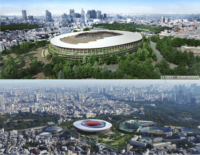Designed and curated by Japanese architectural firm, Atelier Bow-Wow, a promising but ultimately underwhelming exhibition at the Japan Society in New York City extracts examples of architecture from the 1960s and 2000s, using six themes—stadium, station, retail, office, capsule, and home—that are intended to demonstrate both the development of urban life in Tokyo in the 1960s and how that life is being re-examined today. The episodic structure of MADE IN TOKYO: Architecture and Living, 1964/2020 impedes an easy comprehension of the larger narrative. Beyond a few special moments, what is interesting in the exhibit is that which is excluded or left unsaid.
The exuberance and excitement of the post-WWII rise of Japan, national pride in transforming Tokyo for the 1964 Olympic Summer Games, and the shift in urban conditions via technology, has been tempered by the 1990s post-bubble economy and an aging population, and shaken by the 2011 Tohoku earthquake and tsunami. The Olympic Games this time are coming in the wake of China’s rise, Japan questioning its future and a changing global climate, none of which are directly addressed in the exhibition. The results seem to reflect a lost way, or at least one of questioning without particularly clear answers. One gets the sense that the dynamic influence of urban infrastructure and technological progress on architecture in the 1960s has given way to a diverse, ad-hoc round of building and the editing of existing, aging infrastructure—partly out of economy and partly out of changing circumstances and technology. This sense could potentially be a result of the exhibition’s structure, using 1960s-era projects as a point of departure to assess shifts. Or it could reflect the particular interests and sensibilities of its curator/designers, Yoshiharu Tsukamoto and Momoyo Kaijima, who are well-known for their research into, and design of, small-scale, ad-hoc architecture that is human-focused.
At one point in a 30-minute accompanying video, Tsukamoto expresses concern about the flatness imposed by large corporate projects and fears that the vitality and unpredictable juxtapositions that contribute so vividly to street life in Tokyo are being eviscerated. This is manifest in the direct and unfortunate contrast between the superb video of the construction of Kenzo Tange’s 1964 Yoyogi National Stadium for swimming, and the inert model of the New National Stadium, a joint-venture between Kenga Kuma and the Taisei Corporation. Unfortunately, one does not get a real sense of Kuma’s architecture. The presentation seems to convey that the priority is politics, schedule, and budget. The aspirations for a rehabilitated post-war economy have passed into doubt and caution.
Yet there are spots of hope. The strongest of the newer projects show a promising revitalization and a questioning of living both within the city and the shift of offices to depopulated rural areas newly connected by high speed internet. One, Holes in the House, depicts the cutting apart and physical editing of a 1980s-era residence by architects Fuminori Nousaku and Mio Tsuneyama. A line from their statement reads, “Holes in the House will never be completed, as there is no idea of completion.” The architects, who both live and work in the shell of the structure as they do the construction work, are seeking “a new wild urban ecology … and to make the house half off-grid from the city’s energy networks.” They measure and record daily and seasonal fluctuations in temperature and humidity. The architectural design is determined, in part, by the microclimate: holes within the existing floor slabs allow for the easy redistribution of light and air through the space.
Post-Tohoku earthquake, Japan’s power infrastructure proved highly problematic with Tokyo sweltering through the summer humidity. The subtext of the exhibition suggests that technology is increasingly seen as a tool and less as a symbol of progress in its own right. The glamour of newly air-conditioned offices, automobiles, and bullet trains may be giving way to the practicality of pellet stoves, solar panels, and recycled water. High speed internet connections in rural areas are allowing for remote workplaces and the rehabilitation of abandoned buildings in small towns. Perhaps this shift in perception is a good thing and is ultimately more sustainable and hopeful. Tokyo continues to transform.
The exhibition MADE IN TOKYO: Architecture and Living, 1964/2020 is on view at the Japan Society through January 26, 2020.







Post a comment to this article
Report Abusive Comment